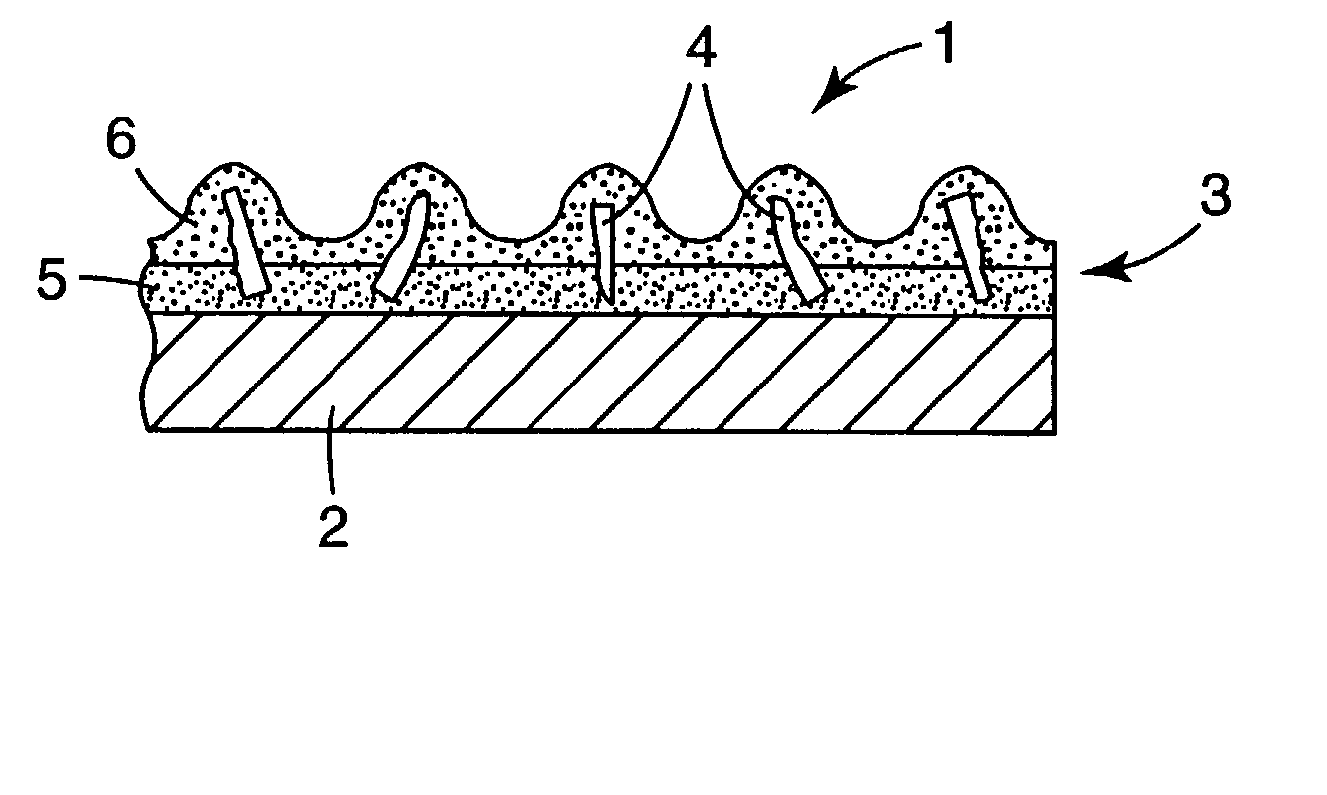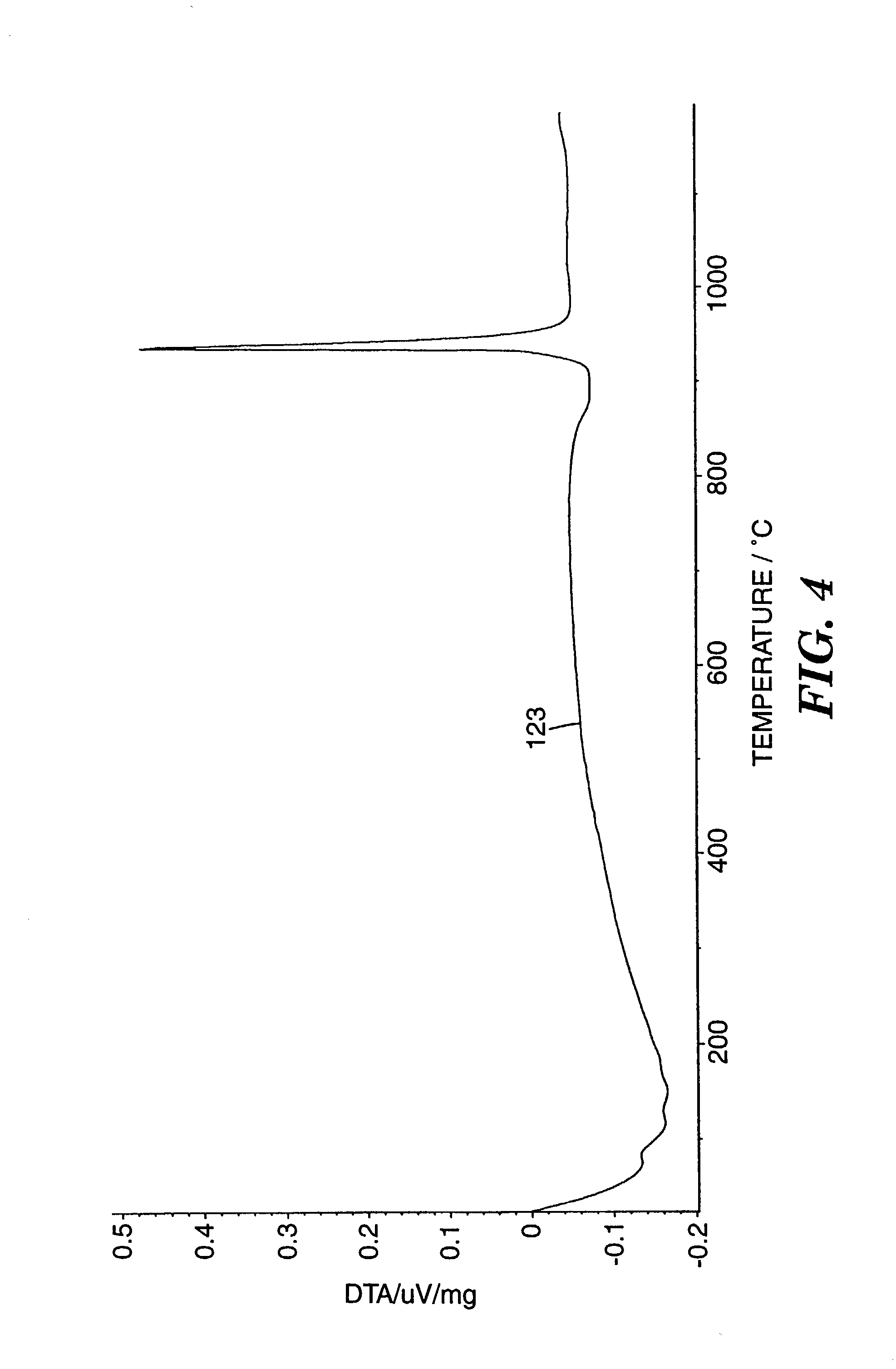Abrasive particles and methods of making and using the same
- Summary
- Abstract
- Description
- Claims
- Application Information
AI Technical Summary
Benefits of technology
Problems solved by technology
Method used
Image
Examples
example 1
[0142] A polyethylene bottle was charged with 819.6 grams of alumina particles (obtained under the trade designation "APA-0.5" from Condea Vista, Tucson, Ariz.), 818 grams of lanthanum oxide particles (obtained from Molycorp Inc.), 362.4 grams of yttria-stabilized zirconium oxide particles obtained from Zirconia Sales, Inc. of Marietta, Ga. under the trade designation "HSY-3") and 1050 grams of distilled water. About 2000 grams of the zirconia milling media (obtained from Tosoh Ceramics, Division of Bound Brook, N.J., under the trade designation "YTZ") were added to the bottle, and the mixture was milled at 120 revolutions per minute (rpm) for 24 hours. After the milling, the milling media were removed and the slurry was poured onto a glass ("PYREX") pan where it was dried using a heat-gun. The dried mixture was ground with a mortar and pestle and screened through a 70-mesh screen (212-micrometer opening size).
[0143] After grinding and screening, some of the particles were fed into ...
examples 2-25
[0144] Examples 2-25 beads were prepared as described in Example 1, except the raw materials and the amounts of raw materials, used are listed in Table 1, below, and the milling of the raw materials was carried out in 90 milliliters (ml) of isopropyl alcohol with 200 grams of the zirconia media (obtained from Tosoh Ceramics, Division of Bound Brook, N.J., under the trade designation "YTZ") at 120 rpm for 24 hours. The sources of the raw materials used are listed in Table 2, below.
1 TABLE 1 Example Weight percent of components Batch amounts, g 2* La.sub.2O.sub.3 48 La.sub.2O.sub.3 240 Al.sub.2O.sub.3 52 Al.sub.2O.sub.3: 260 3 La.sub.2O.sub.3: 43 La.sub.2O.sub.3: 21.5 Al.sub.2O.sub.3: 32 Al.sub.2O.sub.3: 16 ZrO.sub.2: 12 ZrO.sub.2: 6 SiO.sub.2: 13 SiO.sub.2: 6.5 4 La.sub.2O.sub.3: 45.06 La.sub.2O.sub.3: 22.53 Al.sub.2O.sub.3: 34.98 Al.sub.2O.sub.3: 17.49 ZrO.sub.2: 19.96 ZrO.sub.2: 9.98 5 La.sub.2O.sub.3: 38.65 La.sub.2O.sub.3: 19.33 Al.sub.2O.sub.3: 38.73 Al.sub.2O.sub.3: 19.37 ZrO.s...
example 1a
[0156] Example 1A coated abrasive disk was prepared as described for Example 1 except the Example 1A abrasive particles were obtained by crushing a hot-pressed and heat-treated Example 1 material, rather than crushing then heat-treating.
[0157] Comparative Example A coated abrasive discs were prepared as described for Example 6 (above), except heat-treated fused alumina abrasive particles (obtained under the trade designation "ALODUR BFRPL" from Triebacher, Villach, Austria) was used in place of the Example 1 glass-ceramic abrasive particles.
[0158] Comparative Example B coated abrasive discs were prepared as described for Example 6 (above), except alumina-zirconia abrasive particles (having a eutectic composition of 53% Al.sub.2O.sub.3 and 47% ZrO.sub.2; obtained under the trade designation "NORZON" from Norton Company, Worcester, Mass.) were used in place of the Example 1 glass-ceramic abrasive particles.
[0159] Comparative Example C coated abrasive discs were prepared as described a...
PUM
| Property | Measurement | Unit |
|---|---|---|
| Length | aaaaa | aaaaa |
| Fraction | aaaaa | aaaaa |
| Size | aaaaa | aaaaa |
Abstract
Description
Claims
Application Information
 Login to View More
Login to View More - R&D
- Intellectual Property
- Life Sciences
- Materials
- Tech Scout
- Unparalleled Data Quality
- Higher Quality Content
- 60% Fewer Hallucinations
Browse by: Latest US Patents, China's latest patents, Technical Efficacy Thesaurus, Application Domain, Technology Topic, Popular Technical Reports.
© 2025 PatSnap. All rights reserved.Legal|Privacy policy|Modern Slavery Act Transparency Statement|Sitemap|About US| Contact US: help@patsnap.com



